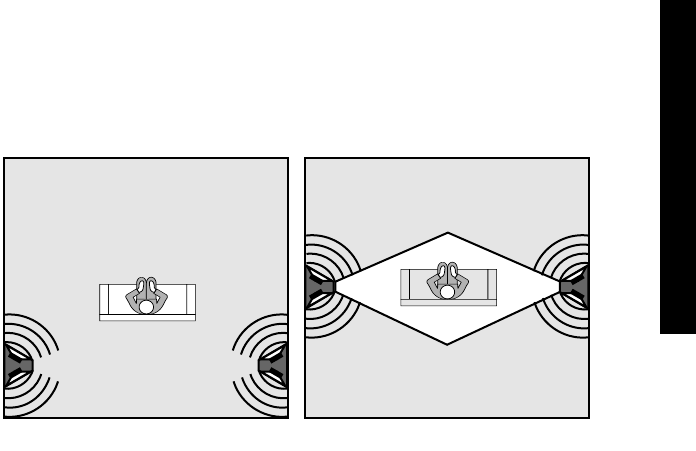
Bipole 5.1 System
Null Zone
Dipole 5.1 System
4. Positioning Surround Speakers
We are often asked about what kind of surround speakers are best:
dipole, bipole, or monopole (direct-radiator). Placement, room
acoustics, and other factors affect the sonic realism of movies and
multi-channel audio at least as much as the radiating characteristics
of a speaker. Therefore, we do not make specific recommendations
but rather suggest you discuss the best solution for your particular
needs with your authorized PSB audio/video specialty retailer or visit
our Web site. Bipole (speakers in-phase) or direct radiating surrounds
placed slightly BEHIND the listening position can offer an
exceptionally convincing diffuse soundfield without calling any
attention to the surround speakers themselves. It should be noted
that in the alternative dipole surround configuration the two baffles of
each surround speaker are out-of-phase with each other creating a
“null” or dead zone of sound in the area along the 90-degree axis of
the speaker. DIPOLE SURROUNDS MUST BE PLACED ON THE
SIDE WALLS DIRECTLY BESIDE THE LISTENING POSITION. The
effect is lost as soon as you move outside the “null”. All PSB
Synchrony Series speakers are timbre matched (have similar tonal
characteristics) for easy mix and match home theater system
flexibility and ultimate performance. Most surround sound is meant
more to create greater depth and overall ambience than to localize
effects as coming from a particular spot. How much you prefer these
localized effects vs. overall sonic depth and diffusion is up to your
listening preferences. If you are listening to multi-channel music from
DVD-Audio or SACD, you may want the maximum localization of
instruments. However, for most home theater applications a diffuse
soundfield might be preferred. You can locate and aim your surround
speakers to produce the effects you prefer, whether precisely
pinpointed or pleasantly diffused. For example, you may choose to
position monitors behind your listening position on stands at ear
height as shown in the diagram at right and, experiment with speaker
11
Owner’s Manual


















